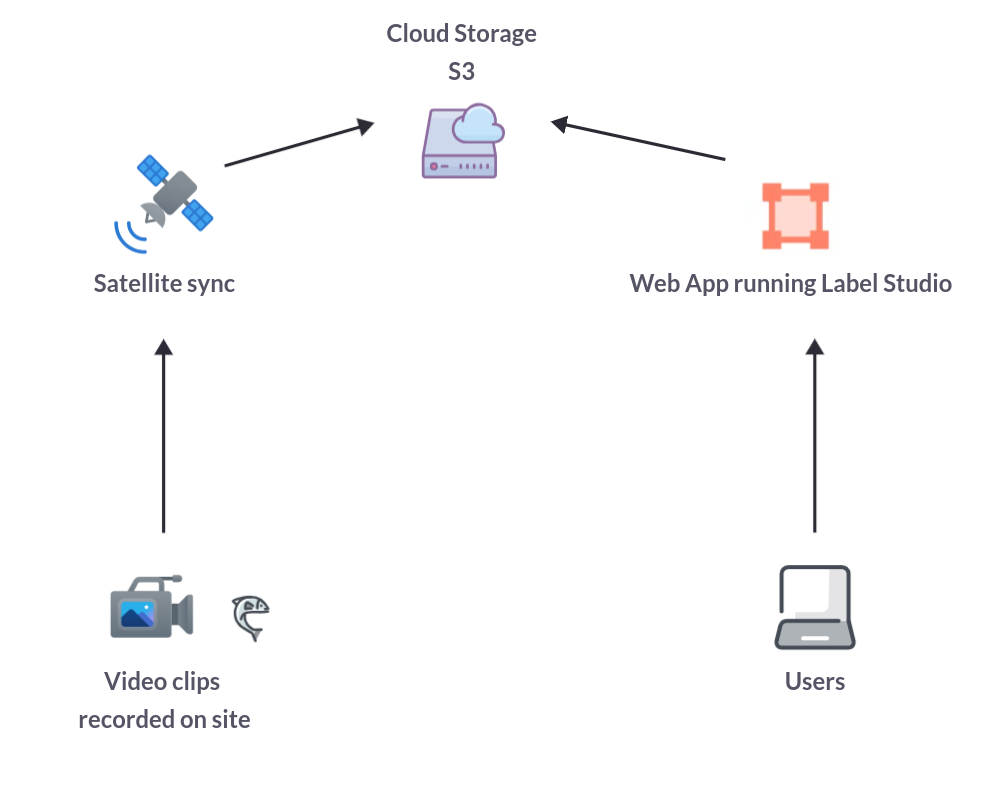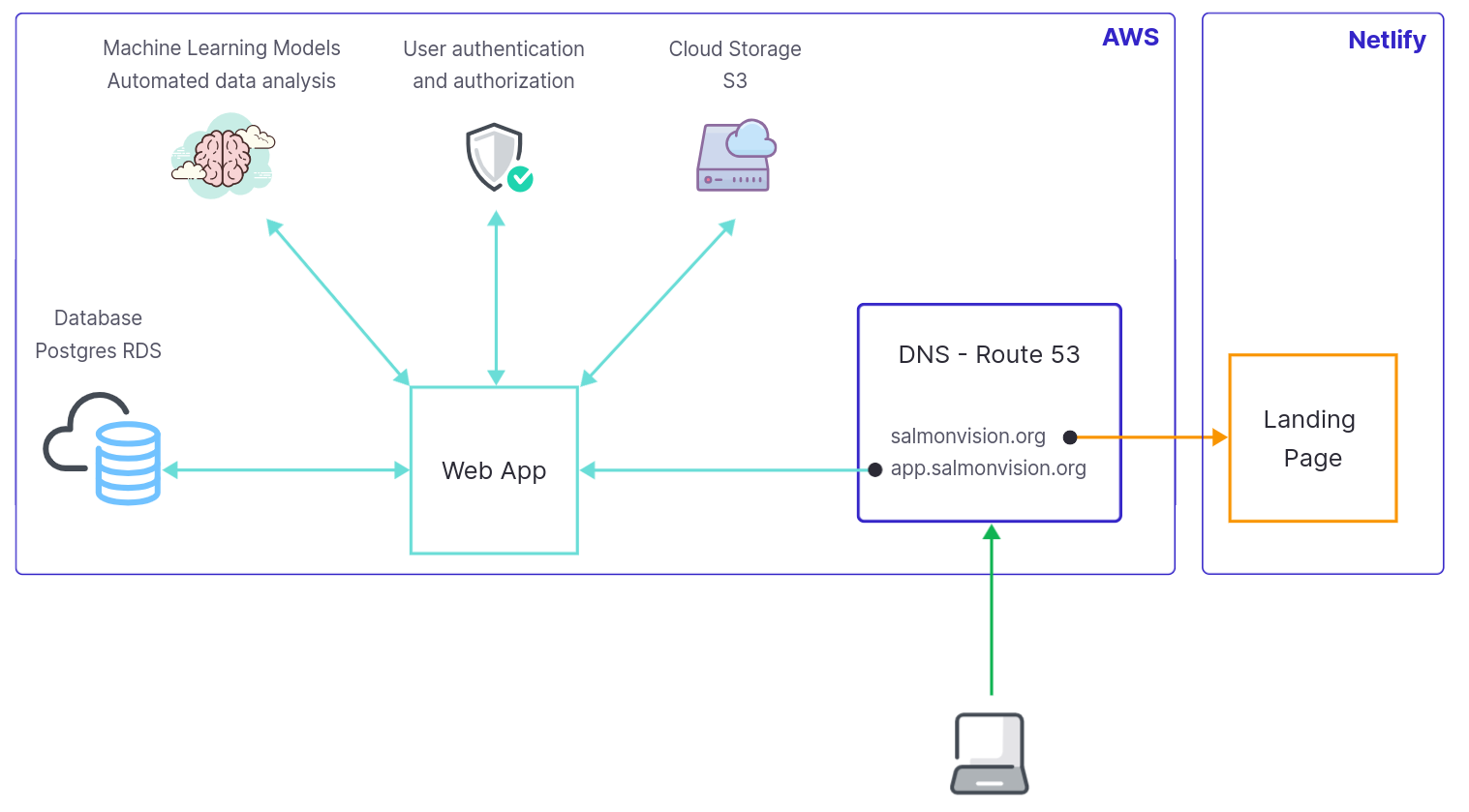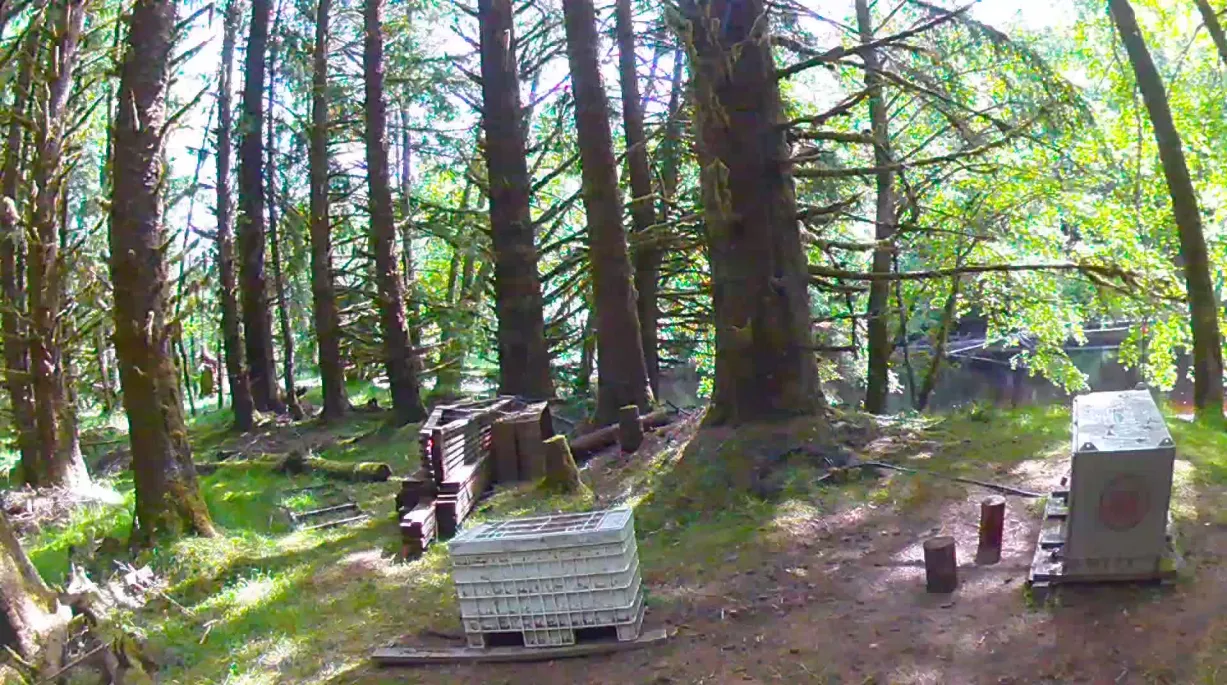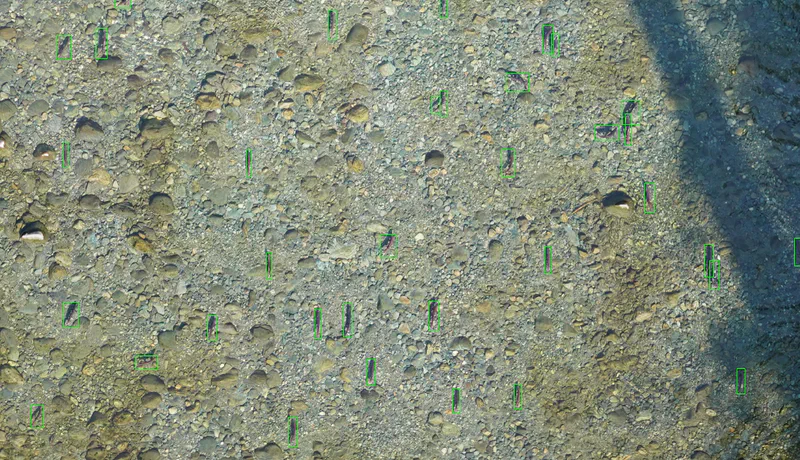Conservation
Wild Salmon Migration Monitoring

Context
Pacific salmon are anadromous, meaning they begin life in freshwater, migrate to the ocean, and return to freshwater to spawn and die. Adult salmon travel long distances, often hundreds of miles, to reach their birthplace. Overcoming various obstacles, they engage in courtship and breeding. The males and females release sperm and eggs simultaneously, which settle in nests (redds) prepared by the females. After spawning, the adult salmon die, their bodies providing nutrients to the surrounding environment. One can learn more about the Pacific salmon life cycle here.
Wild salmon are integral to the ecological, cultural, and economic fabric of British Columbia, underscoring the importance of their effective conservation and management.
Through a collaborative partnership with the Pacific Salmon Foundation (PSF), the Wild Salmon Center, Aeria, and Simon Fraser University, we developed an automated tracking and counting system - SalmonVision - designed to monitor a wide range of salmon species returning to their natal streams.
 Gallery / System overview of the SalmonVision application
Gallery / System overview of the SalmonVision application
Wild salmons are vital for the ecosystems
Wild salmon in British Columbia (BC), Canada, play a crucial role in the ecosystem for several reasons:
- Nutrient Cycling: When salmon return to their natal streams to spawn and die, their bodies decompose and release essential nutrients into the freshwater systems. These nutrients, including nitrogen and phosphorus, support the growth of aquatic plants and microorganisms, which are the foundation of the food web.
- Food Source for Wildlife: Salmon are a key food source for a variety of wildlife, including bears, eagles, wolves, and other predators. The presence of salmon influences the population and health of these species, creating a ripple effect throughout the ecosystem.
- Forest Health: The nutrients from decomposing salmon carcasses also benefit surrounding forests. Trees and plants near salmon-bearing streams grow more robustly due to the nutrient input, contributing to overall forest health and biodiversity.
- Marine and Freshwater Link: Salmon act as a crucial link between marine and freshwater ecosystems. As they migrate from the ocean to freshwater streams, they transport marine nutrients inland, enriching freshwater habitats.
- Biodiversity: The presence of salmon supports a diverse range of species, both directly and indirectly. Healthy salmon populations contribute to the overall biodiversity of the region, making the ecosystem more resilient to changes and disturbances.
- Cultural Importance: For many Indigenous communities in BC, salmon are not only a vital food source but also hold significant cultural and spiritual value. The health of salmon populations is deeply intertwined with the cultural heritage and traditions of these communities.
- Economic Value: Salmon fisheries are economically important for BC, providing jobs and supporting local economies. Sustainable management of salmon populations is crucial for the long-term viability of these economic activities.
Overall, wild salmon are integral to the ecological, cultural, and economic fabric of British Columbia, highlighting the importance of conserving and managing their populations effectively.
Conservation concerns
Wild salmon in British Columbia and around the world face several main conservation threats.
We must take every step in our control now as climate-change related trends will make things more difficult for salmon populations in the years ahead. This demands urgency for Pacific salmon and for the 130+ species, including grizzlies, orcas and eagles, that depend on Pacific salmon.
– Pacific Salmon Foundation
- Habitat Destruction: Urban development, logging, and agriculture can degrade and destroy salmon habitats, particularly spawning and rearing streams.
- Dams and Barriers: Dams and other barriers obstruct salmon migration routes, preventing access to critical spawning and rearing habitats.
- Overfishing: Unsustainable fishing practices can deplete salmon populations, reducing their numbers and genetic diversity.
- Climate Change: Rising temperatures and changing precipitation patterns affect water temperatures and stream flows, disrupting salmon life cycles and habitats.
- Pollution: Runoff from agriculture, industry, and urban areas can contaminate waterways with pollutants, negatively impacting salmon health and survival.
- Disease and Parasites: Increased interactions with farmed salmon and other fish can spread diseases and parasites to wild salmon populations, weakening their health and resilience.
How can a Wild Salmon Migration Monitoring system benefit conservation?
A wild salmon migration monitoring system benefits the conservation of wild salmon in several key ways:
- Accurate Population Tracking: By automatically counting salmon as they migrate, the system provides precise data on population sizes and trends. This information is crucial for assessing the health of salmon populations and identifying any declines or increases.
- Informed Management Decisions: With reliable data on salmon numbers and migration patterns, conservationists and resource managers can make informed decisions about fishing quotas, habitat restoration projects, and other management actions to support salmon conservation.
- Identifying Threats: The monitoring system can help identify specific threats to salmon during their migration, such as obstacles created by dams or pollution levels in certain areas. Addressing these threats becomes more feasible with concrete data.
- Supporting Regulatory Compliance: By ensuring that the number of salmon passing through specific areas meets state regulations, the system helps enforce legal protections for salmon populations. This compliance is essential for maintaining sustainable salmon fisheries.
- Enhancing Habitat Protection: Data from the monitoring system can highlight critical habitats that are essential for salmon spawning and rearing. Protecting these habitats becomes a priority, ensuring that salmon have safe and suitable environments for reproduction and growth.
- Long-term Monitoring: Continuous monitoring over multiple seasons and years provides long-term data that is vital for understanding trends and the impacts of environmental changes, such as climate change, on salmon populations.
- Community and Stakeholder Engagement: By providing transparent and accessible data, the system can engage local communities, Indigenous groups, and other stakeholders in salmon conservation efforts. Informed communities are more likely to support and participate in conservation initiatives.
Project Scope and Collaboration
This project involves a close collaboration with the Pacific Salmon Foundation, the Wild Salmon Center, Aeria, and Simon Fraser University to develop an advanced monitoring system. The system automatically counts different fish species migrating back to their natal streams, utilizing underwater cameras, sonar technology, drone imagery, and satellite connectivity for data streaming, and computer vision systems to generate automated count reports.
 Gallery / Overview of the web application developed to centralize counts reports and video clips
Gallery / Overview of the web application developed to centralize counts reports and video clips
Main Salmon species
Below is a table showcasing the seven main salmon species found in Canada, all of which our systems can automatically recognize and count.
| Species | Description | Image |
|---|---|---|
| Steelhead | Found primarily in eastern Pacific waters, Steelhead can live up to eight years and spawn up to three times, although many, especially males, do not survive that long. They can grow large, with some reaching over 30 pounds and 45 inches in length, though most are between eight and 20 pounds. |  |
| Sockeye | Sockeye salmon, known for their slim, streamlined bodies and brilliant colors, inhabit rivers and lakes of the Pacific Northwest. They are culturally significant to First Nations and provide essential nutrition to many communities. At maturity, usually around four years old, Sockeye weigh between five to 12 pounds and measure 20 to 28 inches in length. |  |
| Pink | Pink salmon are the smallest and most populous Pacific salmon in British Columbia, and the least vulnerable to extinction. They typically weigh between three to 11 pounds and measure 18 to 24 inches in length. |  |
| Coho | Coho salmon are highly adaptable and found in rivers and streams across North America. They typically weigh 8 to 12 pounds and measure 18 to 24 inches in length. |  |
| Chum | Chum salmon are the second largest in the Oncorhynchus genus, after Chinook. They typically weigh between 12 to 15 pounds and measure 35 to 45 inches in length. |  |
| Chinook | Chinook are the largest Pacific salmon, capable of weighing over 100 pounds, though they typically average around 30 pounds. At maturity, they measure between 40 to 60 inches in length. |  |
Additionally, our system categorizes the following fish species: Bull Trout, Rainbow Trout, Whitefish, Shiner, Pikeminnow, Jack Chinook, Lamprey, and Cutthroat Trout.
Deployed Systems
Underwater Cameras
We have deployed underwater cameras equipped with motion sensors. Upon detecting motion, the camera activates, enabling our computer vision system to precisely count fish movements and classify the species.
Underwater Camera Activated at Bear Creek River: Monitoring System Now LiveThis enables the generation of daily counts of fish moving back to their native streams.
Sonar
Sonar, short for Sound Navigation and Ranging, is a technology that uses sound waves to detect objects underwater. It works by emitting pulses of sound waves (sonar pings) and then listening for the echoes bounced back from objects in the water. By analyzing the time it takes for the sound waves to return and the characteristics of the echoes, sonar systems can determine the distance, size, shape, and sometimes even the composition of underwater objects. Sonar is widely used in various applications such as navigation, underwater mapping, fishing, and military operations.
 Gallery/ Setting up sonars at Haida site
Gallery/ Setting up sonars at Haida site
The system is coupled with a sonar that also performs fish counting.
Drone imagery
Drones are increasingly utilized in certain regions to monitor and classify the number of fish migrating upstream. They provide aerial perspectives that aid in accurately reporting fish populations and their movement patterns.
 Gallery / Photogrammetry of a fresh water stream where salmon migrate -
Courtesy to Aeria.ai for the picture
Gallery / Photogrammetry of a fresh water stream where salmon migrate -
Courtesy to Aeria.ai for the picture
Conclusion
Overall, a wild salmon migration monitoring system is a powerful tool for conserving wild salmon by providing the data needed for effective management, identifying and addressing threats, and engaging stakeholders in conservation efforts.
One can try out the model from the ML Space or directly from the snippet below:
Forest Elephants Passive Acoustic Monitoring

